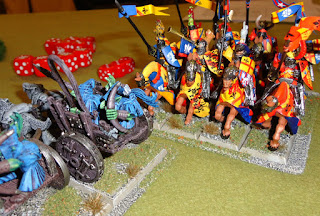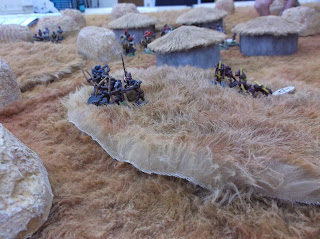I started playing the first edition, Rogue Trader, back in 1987 and I've
built up a lot of armies. 40K dropped out of favour at our club a long time ago
and I've only played 2 games using any of the editions since the first.
When 8th ed. came out with all the armies contained in 5 books I decided to
give it another go. Several others at the club are also interested.
Kev and I played a game with a power level of 39. Power levels are
simplified version of points values and save a lot of time. I'm a believer in
getting what you pay for, but this saved so much time and fiddling with
spreadsheets. Kev's army was rather character heavy, being based on the figures
in the starter set.
He had a Death Guard Chaos Marine force a Lord of Contagion (a chaos
terminator lord type), a Noxious Blightbringer (who boosts friends and hinders
enemies nearby) and a Malignant Plaugucaster (a Psyker), two units of
Plaugemarines, 20 poxwalkers (mindless zombies) and a Rhino.
I took Space Marines with a Lieutenant, 3 tactical squads and a Dreadnought.
They had a rule where I could re-roll failed morale tests, which I forgot. We
also missed the rule that the chaos marines could re-roll 1s to hit Imperial
troops. My figures are all from the 80s, And yes, I need to sort out a lot of
missing backpacks.
We rolled the No Mercy scenario which gave victory points for destroying
enemy units, first blood and having a unit in the enemy deployment zone at the
end of the game. The game lasts 5-7 turns, depending on a dice roll. Kev chose
the deployment zone and picked Front Line Assault.
On my left I put one unit on top of a building with a good field of fire. I
sent another to take on the smaller Plaguemarine squad on the left, and kept my
Lieutenant loitering out of sight waiting for a chance to be useful. I put my
Dread in the centre and another squad on the right.

The poxwalkers came through the centre losing half their number before
climbing up to assault my marines on the roof. They were wiped out after
several turns of fighting, taking 4 marines with them. we also missed the rule
that those casualties had a chance of turning into more pox walkers. My Dred
shot at several units, causing a few casualties and Kev's Psyker cast spells
from the ruins in the centre.
On my left I quickly routed the squad opposite and moved into the centre to
take on the Psyker.
On the right our troops exchanged shots through a building from the doorways
before the Plaugemarines charged, boosted by the Blightbringer. The chaos squad
was wiped out leaving the character but the Lord of Contagion came round the
rear of the marines and joined in. My Dred charged him, was wounded himself and
failed his morale test and was destroyed. The remaining marines were wiped out.
At the end, my squad on the left killed the Psyker, Kev's victorious
characters and Rhino moved into my deployment zone and my Lieutenant made a
dash for the enemy deployment zone for a victory point but didn't make it
before the game ended. I had killed two squads and a character, and drawn
first blood giving me 4 victory points, Kev had destroyed 2 units and got into
my deployment zone for 3.
I like the simplicity of the combat mechanism. Unit cards give the dice
score to hit rather than a value to be compared to something else on a table.
And the wounding mechanism is simpler (equal, more, double). I found the simple
points system surprisingly good, I added up what Kev had in less than a minute
and was able to put a matching force on the table almost as quickly.
The morale system is sadly lacking. Back in the 80s I used to be frustrated
by the fact that by turn 4 the table was full of units either running away, or
having rallied, coming back again. I can't comment on the intervening sets, but
essentially the new system is that morale tests are modified by the casualties
taken and the result of failure is additional casualties (fleeing) according to
how much the test was failed by. There is nothing like suppression, there is
nothing you can do to impede and enemy (such as pinning it down with one unit
so another can advance in safety), except to kill them all. This detracts from
the feeling of a real battle.
I have a lot of armies I'd like to get some use from and there will be players
at the club willing to play this, so it will do. I have thought about
converting other rule sets and writing my own army lists for them, which is a
lot of work and I might not persuade many people to play it. I'll consider
modifying the morale system though.

















































